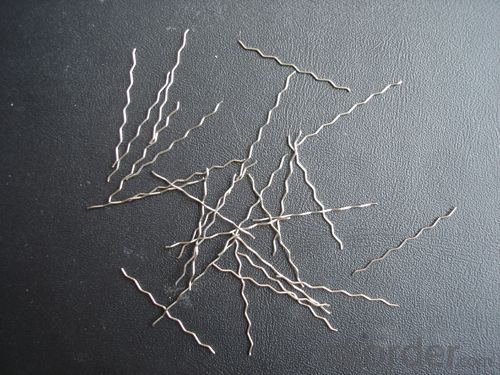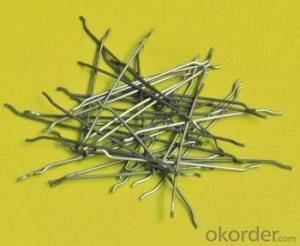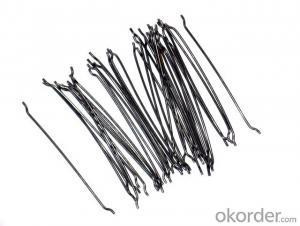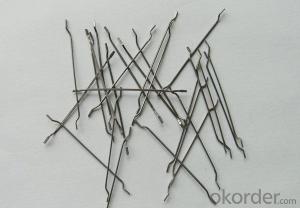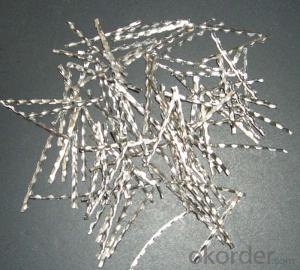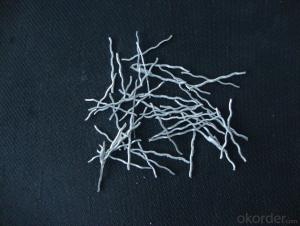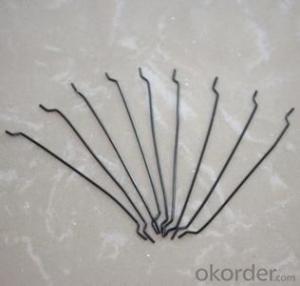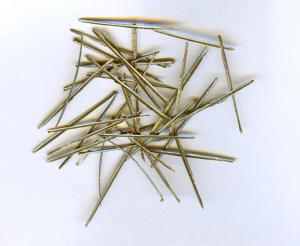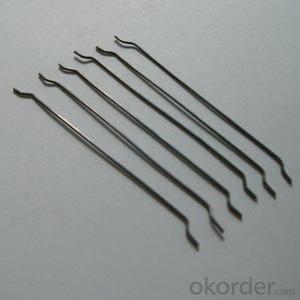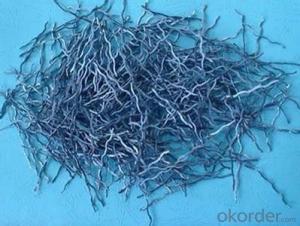Melt Extract Stainless Steel Fiber as Concrete Admixtures CNBM
- Loading Port:
- Tianjin
- Payment Terms:
- TT OR LC
- Min Order Qty:
- 2000 kg
- Supply Capability:
- 250000 kg/month
OKorder Service Pledge
OKorder Financial Service
You Might Also Like
Quick Details
Place of Origin: Shandong, China (Mainland), Shandong, China (Mainland)
material: steel wire
type: wavy steel fiber
shape: corrugated flat fiber
usage: concrete reinforcement
appearance: clear and bright
Product features
steel fiber are for concrete construction, greatly improves concrete bonding and tensile strength .
The steel fiber is made of high-quality low carbon steel wire,with the characteristic of the high tensile strength,good toughness,etcs.This product is widely used in the construction fields for concrete reinforcement
Specifications
| The Specification of Hooker Ends Steel Fiber | ||||
| TYPE | Diameter(mm) | Length(mm) | Length/Diameter | Tensile strength |
| LB-60/60 | 1.0 | 60 | 60 | >=1000Mpa |
| LB-50/50 | 1.0 | 50 | 50 | >=1000Mpa |
| LB-65/60 | 0.9 | 60 | 65 | >=1000Mpa |
| LB-55/50 | 0.9 | 50 | 55 | >=1000Mpa |
| LB-80/60 | 0.75 | 60 | 80 | >=1000Mpa |
| LB-45/35 | 0.75 | 35 | 45 | >=1000Mpa |
| LB-55/30 | 0.55 | 30 | 55 | >=1000Mpa |
| LB-60/30 | 0.5 | 30 | 60 | >=1000Mpa |
| LB-50/25 | 0.5 | 25 | 50 | >=1000Mpa |
| LB-60/25 | 0.4 | 25 | 60 | >=1000Mpa |
Picture
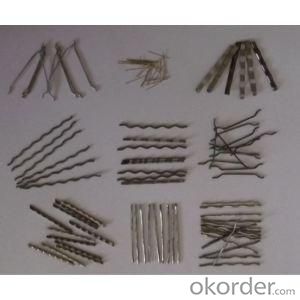
steel fiber for concrete reinforcement
steel fiber are for concrete construction, greatly improves concrete bonding and tensile strength .
The steel fiber is made of high-quality low carbon steel wire,with the characteristic of the high tensile strength,good toughness,etcs.This product is widely used in the construction fields for concrete reinforcement

FAQ
we can produce any type steel fiber and of course we can make production according to your requirement
we have specilize in this field for almost 10 years ,with good quality and competitive price
- Q: How does melt extract stainless steel fiber affect the freeze-thaw resistance of concrete?
- Concrete's freeze-thaw resistance can be significantly enhanced by the addition of melt extract stainless steel fibers. These fibers are incorporated into the concrete mix during the mixing process, acting as reinforcement within the concrete matrix. During freeze-thaw cycles, the water present in the concrete expands as it freezes, exerting pressure on the surrounding material. This pressure can cause cracking and deterioration of the concrete. However, the inclusion of melt extract stainless steel fibers helps to address this issue. The fibers form a three-dimensional network within the concrete, effectively reinforcing it and improving its ability to resist cracking. They enhance the concrete's tensile strength and ductility, enabling it to better withstand the expansion and contraction resulting from freeze-thaw cycles. In addition, the stainless steel composition of these fibers offers excellent corrosion resistance. This is particularly important in freeze-thaw conditions where the presence of water and deicing salts can accelerate the corrosion process. By preventing corrosion, the fibers ensure the structural integrity and durability of the concrete over time. In conclusion, the integration of melt extract stainless steel fibers into concrete enhances its freeze-thaw resistance by reducing cracking, improving tensile strength, and providing corrosion resistance. This leads to a more resilient and long-lasting concrete structure capable of withstanding harsh environmental conditions.
- Q: Does melt extract stainless steel fiber improve the freeze-thaw resistance of concrete?
- Yes, melt extract stainless steel fiber does improve the freeze-thaw resistance of concrete. The addition of stainless steel fibers in concrete enhances its durability and ability to withstand the harsh effects of freeze-thaw cycles. The unique properties of stainless steel, such as its high tensile strength and corrosion resistance, help to reinforce the concrete matrix and prevent cracking or deterioration caused by freeze-thaw cycles. The fibers act as a reinforcement system within the concrete, providing improved resistance against the expansion and contraction of concrete due to freezing and thawing. This ultimately leads to a longer service life for concrete structures and reduces the need for costly repairs or replacements.
- Q: Can melt extract stainless steel fiber be used in pre-stressed concrete applications?
- Yes, melt extract stainless steel fiber can be used in pre-stressed concrete applications. The high tensile strength and corrosion resistance of stainless steel fibers make them suitable for reinforcing concrete structures that are subjected to pre-stressing forces. These fibers can enhance the durability and structural integrity of pre-stressed concrete elements, providing additional strength and preventing cracking or failure under tension.
- Q: Can melt extract stainless steel fiber be used in earthquake-resistant concrete structures?
- Yes, melt extract stainless steel fiber can be used in earthquake-resistant concrete structures. Stainless steel fibers provide enhanced ductility and tensile strength to the concrete, improving its ability to withstand seismic forces. The fibers help to prevent cracking and increase the overall durability of the structure, making it more resistant to earthquake-induced damage.
- Q: Can melt extract stainless steel fiber be used in precast concrete applications?
- Yes, melt extract stainless steel fiber can be used in precast concrete applications. These fibers are commonly added to concrete mixes to enhance their mechanical properties and improve structural integrity. The stainless steel fibers provide reinforcement and increase the tensile strength of the concrete, preventing cracking and enhancing its durability. Additionally, stainless steel fibers are corrosion-resistant, making them suitable for use in precast concrete applications where exposure to moisture or chemicals is a concern. Overall, using melt extract stainless steel fiber in precast concrete can improve the performance and longevity of the structures.
- Q: How does the addition of melt extract stainless steel fiber affect the creep behavior of concrete?
- The addition of melt extract stainless steel fiber positively affects the creep behavior of concrete. Creep is the time-dependent deformation of concrete under a constant load, and it is a significant concern in structural applications as it can lead to long-term deformation and structural failure. When melt extract stainless steel fibers are incorporated into the concrete mix, they enhance the overall mechanical properties of the material. The fibers act as reinforcement, providing additional tensile strength and improving the concrete's resistance to cracking and deformation. The steel fibers also contribute to reducing the overall creep of concrete. They act as internal support, resisting the movement and redistribution of stresses within the concrete matrix. This reinforcement effect helps to distribute the applied load more evenly and reduces the potential for long-term deformation. Furthermore, melt extract stainless steel fibers improve the durability of concrete by increasing its resistance to environmental factors such as shrinkage, thermal cycling, and aggressive chemicals. This enhanced durability contributes to the long-term stability and performance of concrete structures. In summary, the addition of melt extract stainless steel fibers to concrete improves its creep behavior by enhancing its mechanical properties and reducing the potential for long-term deformation. This reinforcement effect leads to increased structural integrity and durability, making it an effective solution for applications where creep resistance is a concern.
- Q: Is melt extract stainless steel fiber resistant to corrosion?
- Yes, melt extract stainless steel fiber is highly resistant to corrosion. Stainless steel fibers are made from a high-grade alloy of steel that contains chromium, which forms a protective layer on the surface of the fiber. This layer, known as a passive layer, prevents the steel from coming into direct contact with corrosive elements in the environment, such as moisture, oxygen, and chlorides. As a result, the fiber remains resistant to rust and corrosion even in harsh conditions, including high temperatures, acidic or alkaline environments, and exposure to chemicals. Therefore, melt extract stainless steel fiber is an excellent choice for applications where corrosion resistance is required, such as in concrete reinforcement, refractory materials, and composite materials.
- Q: How does melt extract stainless steel fiber improve the resistance to cracking in concrete?
- The unique properties and characteristics of melt extract stainless steel fiber contribute to the improvement of crack resistance in concrete. By reinforcing the material, the fibers provide additional tensile strength and ductility when mixed into the concrete. Uniformly dispersed throughout the concrete matrix, the stainless steel fibers form a three-dimensional network that enhances the overall structural integrity. This network effectively distributes and absorbs stresses, preventing cracks from forming and spreading. Furthermore, the high aspect ratio of the fibers, combined with their strong bond to the concrete matrix, enhances the material's load-bearing capacity. As a result, the stainless steel fibers act as micro-reinforcements when exposed to external forces or thermal changes, effectively resisting crack formation and reducing crack width and length. The corrosion resistance of stainless steel fibers is also a significant advantage. Unlike other types of fibers, stainless steel does not corrode even in harsh environments or when exposed to chemicals. This corrosion resistance ensures the long-term durability of the concrete structure, preventing the deterioration of its mechanical properties. Moreover, the inclusion of melt extract stainless steel fibers reduces shrinkage and creep in concrete, which are common causes of cracking. As the concrete dries and cures, shrinkage occurs, often leading to cracks. However, the addition of stainless steel fibers minimizes overall shrinkage, reducing the potential for cracks to form. In conclusion, melt extract stainless steel fibers greatly enhance the crack resistance of concrete. These fibers improve tensile strength, ductility, load-bearing capacity, and corrosion resistance, resulting in a more durable and long-lasting concrete structure.
- Q: What is the effect of melt extract stainless steel fiber on the durability of concrete?
- The use of melt extract stainless steel fiber in concrete significantly improves its durability. The fibers act as reinforcement, enhancing the strength and resistance of the concrete to cracking, shrinkage, and impact. This results in a longer lifespan for the concrete structure, reducing the need for repairs or replacement. Additionally, the stainless steel fibers increase the concrete's resistance to corrosion, making it suitable for various environmental conditions. Overall, the inclusion of melt extract stainless steel fiber positively impacts the durability and performance of concrete.
- Q: Can melt extract stainless steel fiber be used in earthquake-resistant construction?
- Yes, melt extract stainless steel fiber can be used in earthquake-resistant construction. These fibers can enhance the strength and ductility of concrete, improving its ability to withstand seismic forces. They provide reinforcement and help to control crack propagation, making structures more resistant to damage during earthquakes.
Send your message to us
Melt Extract Stainless Steel Fiber as Concrete Admixtures CNBM
- Loading Port:
- Tianjin
- Payment Terms:
- TT OR LC
- Min Order Qty:
- 2000 kg
- Supply Capability:
- 250000 kg/month
OKorder Service Pledge
OKorder Financial Service
Similar products
Hot products
Hot Searches
Related keywords





